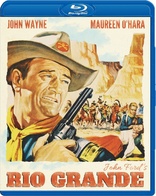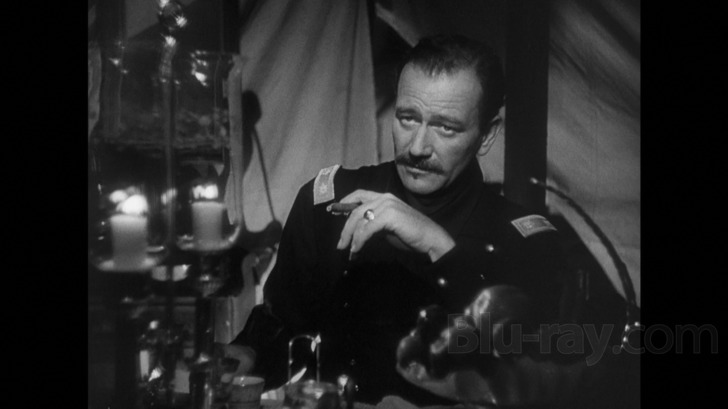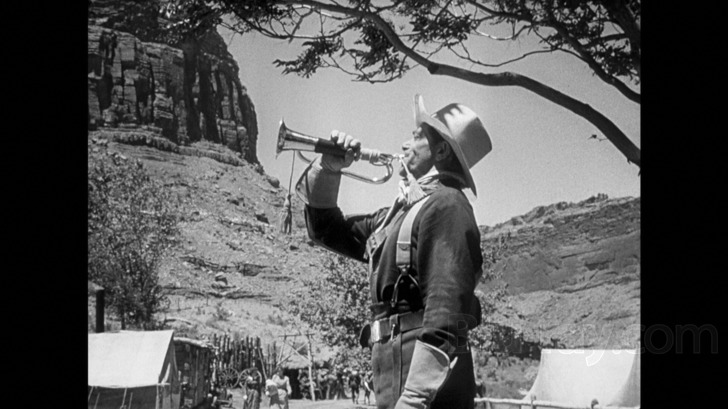Rio Grande Blu-ray Movie
HomeRio Grande Blu-ray Movie 
Olive Films | 1950 | 106 min | Not rated | Aug 07, 2012
Movie rating
7.1 | / 10 |
Blu-ray rating
| Users | 3.8 | |
| Reviewer | 4.0 | |
| Overall | 3.8 |
Overview
Rio Grande (1950)
A U.S. Cavalry unit, on the Mexican border in the 1880's, conducts a vain campaign against marauding Indians.
Starring: John Wayne, Maureen O'Hara, Ben Johnson, Claude Jarman, Jr., Harry Carey Jr.Director: John Ford
| Western | Uncertain |
| Romance | Uncertain |
Specifications
Video
Video codec: MPEG-4 AVC
Video resolution: 1080p
Aspect ratio: 1.35:1
Original aspect ratio: 1.37:1
Audio
English: DTS-HD Master Audio Mono
Subtitles
None
Discs
25GB Blu-ray Disc
Single disc (1 BD)
Packaging
Slipcover in original pressing
Playback
Region free
Review
Rating summary
| Movie | 3.5 | |
| Video | 4.0 | |
| Audio | 3.5 | |
| Extras | 1.5 | |
| Overall | 4.0 |
Rio Grande Blu-ray Movie Review
Lesser Ford is still greater than most.
Reviewed by Jeffrey Kauffman July 12, 2012When you grow up in a certain area, you can become immune to how others not from that area actually perceive it. Having been born and raised for the first part of my life in Utah, it used to outright shock me when people would mention the beauty of Southern Utah, an area I visited regularly and loved, though it struck me as barren and kind of depressing, especially with regard to the decrepit Native American encampments that dotted the region. My family’s relatives, mostly from the East Coast, kept mentioning how stunningly beautiful the area was and often incorporated references to various John Ford movies in their appreciations, and that struck me as even more incredible. How could anyone actually choose Utah as a filming location, my young (albeit obviously already jaded) mind would ask. And yet now from the perspective of a hopefully somewhat wiser adult, it’s hard not to revel in the glories of the Utah landscape that Ford obviously cherished and which he brought to a vast film going public who, if they had visited Utah at all, more than likely stayed in the relatively more populated urban areas of the state’s northern climes, where Salt Lake City, Provo and Ogden are. Many of Ford’s most fondly remembered films exploit the bizarre, almost Moon-like ambience of the American Southwest, and if Ford didn’t utilize Utah exclusively in this regard, he certainly made the state a kind of home away from home for the bulk of his Western directing career. Large swaths of Rio Grande were filmed in and around Moab, a dusty southern Utah burg that wasn’t much more than a town even when I was a kid, which means it probably barely was a village when Ford was filming there. Rio Grande is frequently included in what is called Ford’s “cavalry trilogy”, a triptych of films which also includes 1948’s Fort Apache and 1949’s She Wore a Yellow Ribbon. The connection between Fort Apache and Rio Grande is perhaps more concrete in that John Wayne portrays the same character, Kirby York (alternatively spelled Yorke) in both films, but the fact is Rio Grande probably wasn’t thought of as part of any formal trilogy by Ford at all, as he made the film in a convoluted deal that was agreed to so that Ford could finally get on to the film he really wanted to make and which remains to this day one of the most fondly remembered of all movies helmed by the director, 1952’s The Quiet Man.

Ford’s Western oeuvre is remarkably adroit and innovative, but at least one major plot element of Rio Grande may strike some viewers as old fashioned and at least somewhat objectionable. Even more so than in Fort Apache, the Native Americans in Rio Grande are marauding villains with no nuance and certainly no recognition within the film itself that they have any right to be where they are. Rio Grande simply takes Manifest Destiny as a given and doesn’t attempt to peer beneath the covers. This was of course de rigeur for the time, but it can still seem almost breathtakingly insensitive to modern sensibilities.
Aside from the attacking Native American angle, the rest of Rio Grande rests at times uncomfortably on some family dysfunctions, as evidenced by Yorke’s son Jeff (Claude Jarman, Jr.), who shows up at his father’s command after having gotten kicked out of West Point, and by Yorke’s estranged wife Kathleen (Maureen O’Hara), who similarly shows up in order to reclaim her son and keep him out of harm’s way. Playing out against this family drama (some might argue melodrama) are both music and comedy bits, seemingly shoehorned into the proceedings (as they so often were in B westerns back in that day) to simply provide a little distraction and pad the running time. These bits do offer screen time to a coterie of Ford regulars and others, including Victor McLaglen, Ben Johnson, Chill Wills and the Sons of the Pioneers.
It would be easy to simply view Rio Grande as a knockoff done by Ford and his stars so that they could move on to the Irish themed film which really appealed to all of them, but the fact is Ford manages to invest even this lesser effort with several memorable moments. The simmering sexual tension between Wayne and O’Hara is palpable, perhaps not quite as stormy as it would be in The Quiet Man, but here given a remarkably mature, measured look that is realistic and very appealing. While the climax to the film is (again) a little troubling for modern day audiences, Ford stages it with his usual aplomb, whipping up a nice little frenzy of excitement as Wayne and his troops attempt to rescue a cadre of kidnap victims who have been taken by those evil Apaches.
One of the most remarkable elements of Rio Grande is also one of the easiest to miss: the simple brilliance of John Wayne’s performance. Wayne had such a larger than life persona and frankly fell into such a rut of more or less playing himself in his sixties and seventies films that an overlay of audience expectation sometimes deprives the viewer of being able to see some very subtle and well done characterization. His Kirby Yorke is obviously a conflicted character, one wanting intimacy with both his son and his wife but unsure how to forge those relationships appropriately. Wayne manages to convey incredible emotion here and for all the film’s rote failings, it still shows what a commanding presence its star was, especially under the direction of John Ford.
Rio Grande Blu-ray Movie, Video Quality 

Rio Grande is presented on Blu-ray courtesy of Olive Films with an AVC encoded 1080p transfer in 1.35:1. This is another really solid looking high definition presentation from Olive, aside from a few niggling concerns which are directly related to the condition of the elements. Contrast is generally extremely strong, with nicely brilliant whites and deep convincing blacks, as well as a well modulated gray scale. The image is sharp and clear, though occasionally suffers from a lack of shadow detail in some of the more dimly lit scenes. The high definition presentation makes some of the rear projection much more visible than it has been on previous releases, and there are a few sections that suffer from quite a bit of scratching and other damage (see screencap 14 for a good example). As is the standard operating procedure with most of the Olive Films releases, there appears to have been no digital tweaking of this film, so grain is apparent and natural.
Rio Grande Blu-ray Movie, Audio Quality 

Rio Grande is presented with a lossless DTS-HD Master Audio Mono mix which sounds remarkably good for its age, especially with regard to the colorful score by Victor Young. From the opening blast of the bugle to some of the rousing cues accompanying the attack scenes, Young's boisterous score sounds nicely full bodied. Dialogue is cleanly presented, though there are a few sound effects along the way which this lossless outing reveal as having been ported in, perhaps from effects libraries, with noticeably different reverb and ambience. While there is the expected boxiness, especially with regard to the midrange, this is one of the nicer sounding older mono tracks we've had from Olive.
Rio Grande Blu-ray Movie, Special Features and Extras 

- The Making of Rio Grande (SD; 21:15). "Ruh-roh," as Scooby-Doo might say: the menu lists this featurette as The Making of 'High Noon'. Olive has been releasing so many Blu-rays lately I frankly can't blame them for this slip up, even if it is kind of funny. This is another Leonard Maltin hosted outing (like the High Noon enterprise, in fact) and is a great piece of background information for fans of the film. Interview subjects include Harry Carey, Jr. and Michael Wayne. What's up with that weird kinescope-esque masking of the upper corners of the image in Maltin's hosting segments?
- Trailer (SD; 1:38)
Rio Grande Blu-ray Movie, Overall Score and Recommendation 

Rio Grande was pretty much dismissed at the time of its original release as second rate Ford, and while that assessment can't be totally denied, the fact is the film has a lot of redeeming characteristics and it's held in much higher esteem now than it was in 1950. Performances are top notch, especially by the underappreciated Wayne, who manages to convey a lifetime of regret and pain in a glance or two. O'Hara is considerably more subdued than she is in The Quiet Man, but there is a real chemistry between these two stars that is palpable. The treatment of the Native Americans in the film is probably going to be the most problematic element to modern day audiences, but there's a reason Westerns used to be thought of as "Cowboys versus Indians", and that more or less is what's on display here. This release boasts solid video and audio and comes with an interesting (if misidentified) featurette. Recommended.
Similar titles
Similar titles you might also like

Fort Apache
1948

She Wore a Yellow Ribbon
Warner Archive Collection
1949

Jane Got a Gun
2015

The Glory Guys
Limited Edition to 3000
1965

The Train Robbers
1973

The Spikes Gang
1974

Eagle's Wing
1979

Tomahawk
1951

Apache
1954

The Last Sunset
El Perdido
1961

Posse
1993

The Tall Men
Limited Edition to 3000
1955

Billy Two Hats
1974

Angel and the Badman
1947

The Unforgiven
1960

The Horse Soldiers
1959

Major Dundee
1965

The Kid
2019

The Man from Laramie
Limited Edition to 3000 - SOLD OUT
1955

Lonely Are the Brave
1962
